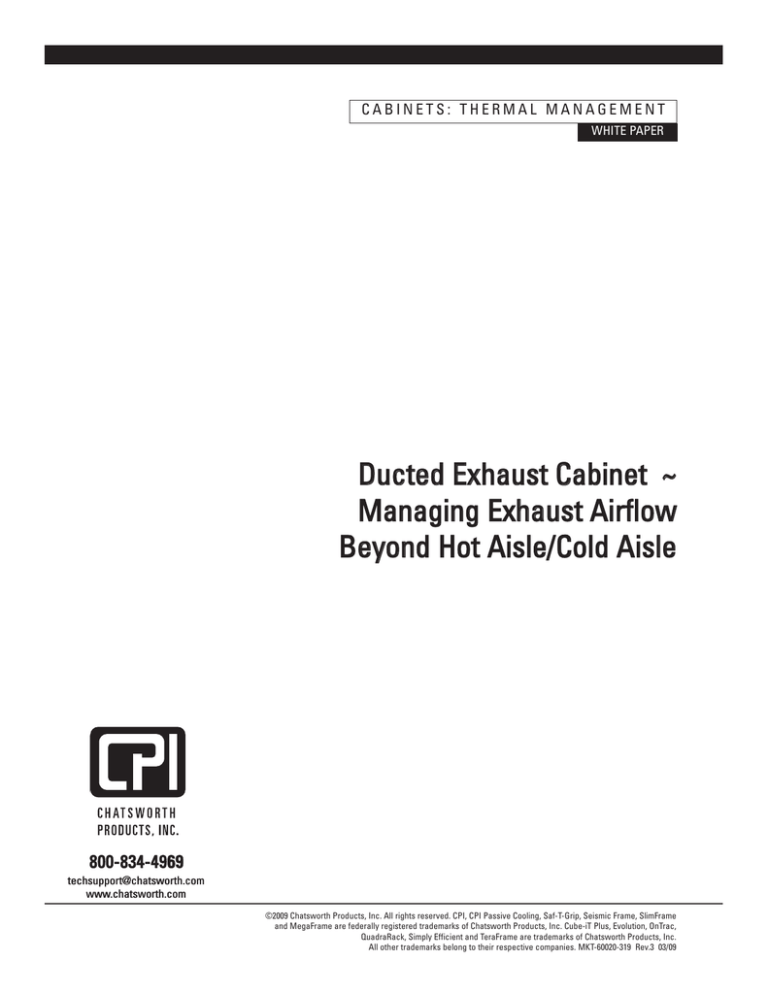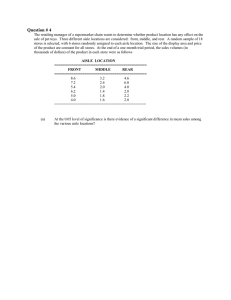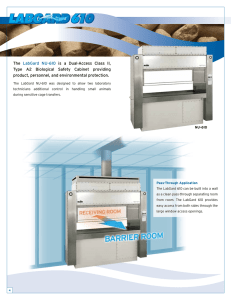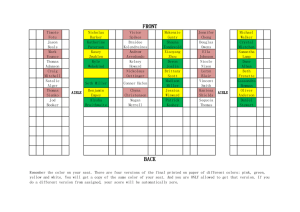
CABINETS: THERMAL MANAGEMENT
WHITE PAPER
Ducted Exhaust Cabinet ~
Managing Exhaust Airflow
Beyond Hot Aisle/Cold Aisle
800-834-4969
techsupport@chatsworth.com
www.chatsworth.com
©2009 Chatsworth Products, Inc. All rights reserved. CPI, CPI Passive Cooling, Saf-T-Grip, Seismic Frame, SlimFrame
and MegaFrame are federally registered trademarks of Chatsworth Products, Inc. Cube-iT Plus, Evolution, OnTrac,
QuadraRack, Simply Efficient and TeraFrame are trademarks of Chatsworth Products, Inc.
All other trademarks belong to their respective companies. MKT-60020-319 Rev.3 03/09
Beyond Hot Aisle / Cold Aisle – Managing Exhaust Airflow
Rack-mount computer and data storage equipment generates heat during normal operation. When equipment
is enclosed in cabinets, heat generated by the equipment can concentrate within the cabinet and cause
equipment to overheat and shut down.
Contemporary thinking in data center thermal management promotes a Hot Aisle / Cold Aisle approach to
segregate cold air in front of rows of equipment cabinets and hot exhaust air behind these rows of cabinets.
This approach works well in low to medium density data center applications. Unfortunately, though, the Hot
Aisle / Cold Aisle approach does not perform well in many medium density applications and can not begin to
support high density applications without extreme discipline and additional air flow management devices
outside of the cabinets to prevent hot exhaust recirculation into the cold aisle.
CPI’s Ducted Exhaust Cabinet uses Managed Exhaust Airflow to deliver superior thermal management by
allowing the equipment to draw the required volume of air through the cabinet, and then directing the exhaust
out of and away from the cabinet, completely eliminating the problem of hot air recirculation. This simple
approach delivers enhanced cooling of equipment resulting in a more efficient use of available cool air and
better overall heat transfer away from equipment.
How Equipment Is Cooled
Heat is removed from rack-mount equipment using forced air convection. Internal fans draw or push air
through the equipment chassis front-to-rear over the heated components within.
The air absorbs the heat from the internal components and carries the heat away as it exits the equipment
chassis. This heat transfer is governed by the following thermodynamic equation:
Q = hA(Tw-Tf)
Where:
Q = the heat transfer rate
h = the convection heat transfer coefficient
A = the surface area
Tw = the temperature of the surface
Tf = the temperature of the fluid
Ducted Exhaust Cabinet ~
Managing Exhaust Airflow Beyond Hot Aisle/Cold Aisle
1
A review of the variables above will quickly reveal that the temperature of the delivered air (Tf) is the only
variable over which the equipment installers and users have any control. All other variables are internal to
the equipment chassis.
The Goal Of Thermal Management In The Data Center
The primary goal of thermal management (as well as power management) in the data center is to maximize
the performance, uptime and life expectancy of the active equipment used by your enterprise. (The secondary
goal is to deliver the primary goal at the lowest possible cost.)
This goal is accomplished by managing the cold air delivered to every piece of equipment such that the
internal temperature of all equipment in the data center never exceeds the manufacturer’s maximum
allowable operating temperature. The cold air delivered to the equipment must be at or below the
manufacturer’s recommended temperature and in sufficient volume to meet the equipments’ CFM (cubic feet
per minute) requirements.
Measurement Of Cooling
We can measure the amount of cooling taking place inside of any particular piece of equipment, like a server
chassis, using the equation for sensible cooling (sensible cooling is the removal of heat that causes a change
in temperature without any change in humidity):
Cooling = 0.317 * ΔTT * CFM
Where:
Cooling is in Watts
ΔT is the difference in air temperature (°F) between the intake and exhaust
CFM is the airflow through the chassis in cubic feet per minute
It is important to note that the air flow (CFM) through the server chassis is primarily controlled by the internal
fan installed by the manufacturer. While it is possible to reduce this throughput by constricting airflow through
an equipment cabinet, it is actually quite difficult to appreciably increase the CFM through a server chassis
with additional fans in an equipment cabinet.
Also of interest is that ΔT does not change very much for different intake air temperatures. Lowering the
intake air temperature will reduce the temperature of the processor(s) inside of a server, but ΔT and the total
cooling taking place do not change (for a constant CFM).
Therefore, any cabinet that does not choke the airflow through the equipment mounted inside and prevents
recirculation will effectively dissipate all of the heat generated by the equipment.
Preventing Recirculation & Bypass Airflow
Recirculation is defined as the condition when hot exhaust air travels back into the equipment intake air
stream. This out-of-control exhaust airflow raises intake air temperatures and will cause equipment to run at
higher operating temperatures.
Bypass airflow is another out-of-control condition which occurs when cold source air bypasses the active
equipment and travels directly into the hot exhaust air stream. This situation wastes energy, contributes to
humidity control problems, and can indirectly contribute to recirculation.
Ducted Exhaust Cabinet ~
Managing Exhaust Airflow Beyond Hot Aisle/Cold Aisle
2
The first step in preventing these undesirable airflow problems is to insure that neither takes place inside the
cabinet. It is widely understood that filler panels should always be used to fill open rack-mount spaces
between equipment inside cabinets. Less widely known is that air can recirculate around the sides of
equipment in a cabinet.
BAD
GOOD
Air dams or an equivalent structure must be used in the sides of equipment cabinets to block this pathway.
Hot Aisle / Cold Aisle data center environments typically do not operate at ideal conditions. When insufficient
volumes of cold air are delivered in the cold aisle, air is pulled over the tops of the cabinets from the hot aisle.
This means that servers near the top of some cabinets may be ingesting air that is 20 or 30 degrees warmer
than the air being delivered through the raised floor.
HOT
AISLE
COLD
AISLE
HOT
AISLE
COLD
AISLE
RECIRCULATION
ByPASS
AIRFLOW
In the diagram above, bypass airflow in the hot aisle is reducing the amount of cold air that can be delivered
in the cold aisle. Cable penetrations and perforated tile in the hot aisle reduce the static pressure under the
raised floor. This leads to less airflow through the perforated tile in the cold aisle. If the servers in the cabinet
draw more air than is delivered through the raised floor in front of the cabinet, then air will flow from the
nearest source. This is usually hot air recirculating over the top of the cabinets.
Under ideal circumstances, all recirculation and bypass airflow can be eliminated. Removing perforated tiles
from the hot aisle and installing KoldLok raised floor grommets in the cable cutouts in the rear of the cabinet
eliminates undesired bypass airflow. A data center with ideal airflow will deliver cold air at the same
temperature to every piece of equipment. Without recirculation, all of the air in the cold aisle will be the same
temperature.
Ducted Exhaust Cabinet ~
Managing Exhaust Airflow Beyond Hot Aisle/Cold Aisle
3
HOT
AISLE
COLD
AISLE
HOT
AISLE
COLD
AISLE
Unfortunately, strict discipline and careful airflow balancing are required to maintain this ideal operating
condition in higher density data center environments. While an initial installation may realize these ideal
conditions, moves, adds and changes, along with the demands for constantly monitoring and rebalancing,
frequently make maintaining this ideal operating condition impractical, if not outright impossible. This is why
inlet air temperatures are never uniform across the front of a cabinet, let alone uniform throughout a data
center.
90°F
72°F
85°F
78°F
72°F
73°F
70°F
72°F
65°F
Traditional Data Center
Ideal Data Center
Ducted Exhaust Cabinet ~
Managing Exhaust Airflow Beyond Hot Aisle/Cold Aisle
4
Limitations Of Hot Aisle / Cold Aisle
Hot Aisle / Cold Aisle is a good data center architecture. Segregating the cold air in front of equipment
cabinets and hot exhaust air behind them is well principled. But we know that maintaining the segregation
is difficult. In order to maintain proper segregation, the CFM of air delivered to each cabinet must roughly
equal the CFM required by all of the active equipment (servers) in each cabinet.
The volume of air that moves through a perforated floor tile is dependent on the static pressure under the
raised floor. In data centers with ideal static pressure of 0.1 inches of water, a perforated floor tile (25%
open area) can deliver up to 700 CFM of cold air. Typical data centers floors where bypass airflow is
prevalent only reach a static pressure of 0.015 to 0.025 inches of water. Under these conditions a perforated
floor tile can only deliver 200-350 CFM of cold air.
If we assume a 48” wide cold aisle (two 24” tiles wide), then each cabinet only has one floor tile positioned
in front of it. The other floor tile is for the cabinet in the opposite row. Under optimum conditions, each tile
will deliver 600-700 CFM.
Server manufacturers design their products to consume an appropriate volume of air for the heat that they
generate. However, not all manufacturers design around the same temperature rise across their
components. A typical rule of thumb is that the temperature will rise 27°F (15°C) between the intake and
exhaust of a server. But actual measurement of an IBM eServer BladeCenter under full load indicated a
42°F temperature rise (ΔT).
Referring back to the sensible cooling calculation, we can plot the sensible cooling curve for any specific
ΔT. Given that a single perforated tile can only deliver a maximum of 700 CFM, we can see that we are
limited to between 4kW and 9kW per cabinet in a perfect Hot Aisle / Cold Aisle implementation (with 48”
wide cold aisles).
Sensible Cooling
25,000
∆T
Watts
20,000
15 F
25 F
42 F
15,000
10,000
5,000
1800
1600
1400
1200
1000
800
600
400
200
0
-
CFM
Certainly we could entertain moving to grates instead of perforated tiles, or we could make our cold aisles
wider. But any way you look at it, the limited square footage of the cold aisle becomes a constraint on the CFM
you can deliver and therefore the heat you can remove from your equipment cabinets.
Ducted Exhaust Cabinet ~
Managing Exhaust Airflow Beyond Hot Aisle/Cold Aisle
5
Beyond Hot Aisle / Cold Aisle – Managing Exhaust Airflow
Hot Aisle / Cold Aisle starts with the correct premise – to segregate cold source air from the hot exhaust air
in the data center.
If we take the Hot Aisle / Cold Aisle philosophy of segregating airflows to the next level, we arrive at Managed
Exhaust Airflow. Managed Exhaust Airflow completely segregates the hot exhaust air by directing it up an
exhaust duct at the top rear of the cabinet.
Typically, the exhaust duct is connected to a drop ceiling return air plenum. But this is not necessary where
high ceilings can offer sufficient clearance for the return air to stratify above the cold air in the room.
Several benefits become obvious with this architecture. Cabinets do not have to be oriented front-to-front and
back-to-back along hot aisle / cold aisle rows. This freedom allows cabinet arrangement to be driven by other
infrastructure requirements.
An even more significant benefit is that up to 100% of the exposed floor can be perforated. Perforated tiles can
now be located anywhere in the room. Managed Exhaust Airflow allows the entire data center to be cold – no
more hot zones. Cold intake air can be pulled from anywhere in the room. A cabinet no longer has to obtain all
of the CFM required from the raised floor tile directly in front or adjacent to it. CFM balancing issues practically
disappear.
By enabling cold air to be delivered through 100% of the tile in the raised floor, we can easily double the CFM
available to any given cabinet and therefore double the heat load capacity.
Managed Exhaust Airflow also creates the opportunity to deploy high density applications in a non-raised
floor environment. Cold air can be delivered directly into the room. It does not require a raised floor.
Ducted Exhaust Cabinet ~
Managing Exhaust Airflow Beyond Hot Aisle/Cold Aisle
6
CPI’s Ducted Exhaust Cabinet
CPI has developed and tested the Ducted Exhaust Cabinet that utilizes Managed Exhaust Airflow. This design
avoids any dependency on booster fans, with the accompanying concerns over additional heat loads, fan
failure and redundancy, thereby qualifying the Ducted Exhaust Cabinet for Tier Three and Tier Four criticality
applications.
TeraFrame™ Cabinet System
with Vertical Exhaust Duct
shown without side panel
The basic cabinet configuration is similar to other CPI server cabinets. The most obvious feature is the large,
low-restriction exhaust air duct at the top rear of the cabinet. The front door is high flow perforated metal. The
rear door is solid.
Ducted Exhaust Cabinet Performance
The Ducted Exhaust Cabinet design assumptions were confirmed in third party testing at extreme heat load
densities.
CPI’s Ducted Exhaust Cabinet was fully loaded with six 7U IBM eServer BladeCenter chassis. Each chassis
held 14 dual-processor HS-20 blade servers (Intel Itanium 3.2 GHz). Each IBM blade chassis utilized four
2000W (nameplate) power supplies, two of which are redundant and are normally idle. Additionally, the server
chassis incorporate dual 350CFM nominal output centrifugal blowers. The blowers are variable speed and
configured for redundancy.
The test cabinet was installed in an active data center at the end of a cabinet row. The datacenter is laid out
with a “hot isle-cold isle” configuration. The cabinet was powered by two 208V, 60A 3-phase circuits.
The cabinet was instrumented with 14 digital temperature probes; one probe was centered in the intake flow
stream of each of the 6 blade chassis. Likewise, a probe was located in the center of the lower blower
exhaust of each of the server chassis. The remaining two temperature probes were positioned to measure the
supply/floor air temperature and the exhaust duct air temperature.
Ducted Exhaust Cabinet ~
Managing Exhaust Airflow Beyond Hot Aisle/Cold Aisle
7
A vane type flow anemometer was used to measure CFM and velocities at the inlet and exhaust locations.
Additionally, a hot wire anemometer/ differential pressure instrument was used to capture static pressure and
flow velocities within the cabinet exhaust duct.
INTERMEDIATE
STRINGERS ADDED
22 1/2" x 22 1/2" Hot Air
Duct
V
T
T
T
T
T
T
T
T
T
T
T
T
“COLD”
AISLE
HO
TA
INSTRUMENTATION
T TEMPERATURE
P STATIC PRESSURE
V VELOCITY
IR
COLD AIR
24" x 48" Cabinet
COLD AIR
23" x 77" Solid Door
P
COLD AIR
HOT AIR
T
T
COLD AIR
An average temperature differential of 42°F was measured across the test blade server chassis under the full
load condition. The air flow through the cabinet was measured at 1642 CFM (at the top of the exhaust duct).
This data indicates a thermal load of:
21.86 kW = 1642 CFM * 42°F * 0.317 / 1,000
A simultaneous measurement on the power feeds to the cabinet under full load was also performed and
corresponded closely to the thermal energy measurement.
21.93 kW = (30.5A + 29.4A) * 208V * √3
This test demonstrated that the Ducted Exhaust Cabinet can easily support 22 kW of heat load in the proper
data center environment. It also indicated that the cabinet could dissipate even more heat under appropriate
circumstances.
High Performance Data Center Installation
The Ducted Exhaust Cabinet was designed specifically for High Performance Data Centers. A High
Performance Data Center (HPDC) is designed to support high density server applications with power/heat
densities exceeding 250 W/sq ft (Net). That translates into average cabinet densities in the 11-25 kW range.
Ducted Exhaust Cabinet ~
Managing Exhaust Airflow Beyond Hot Aisle/Cold Aisle
8
The HPDC concept is being driven by leading edge corporations and institutions that understand the trends in
power consumption and also see the opportunity to leverage a new data center airflow paradigm. This new
HPDC will utilize a combination of existing as well as emerging technology in air conditioning to deliver higher
performance and lower TCO (total cost of ownership) than existing data centers. When measuring the cost
per server (rather than cost per square foot), early indications are that the cost of a HPDC could be one fifth
that of a traditional data center. Calculating costs savings by comparing total data center cost per kW of
equipment supported results in similar cost advantages available with Ducted Exhaust Cabinets in High
Performance Data Centers.
A first generation HPDC utilizing the Ducted Exhaust Cabinet has been successfully implemented. This data
center was designed to support 14 kW per cabinet, each cabinet loaded with 4-5 7U blade server chassis.
Cooling is provided by recirculation air handling units (RAH) delivering chilled air both above and beneath the
raised floor. Air is released into the “cold aisle” through 50% open floor tiles (grates). Cold air also floods the
room through floor-level vents at the bottom of RAH units on the walls at the ends of the cabinet rows. The
volume of airflow is manually balanced against the demand of the server equipment using variable speed fans
and bypass air vents (egg crate grills) that allow air in the room to flow directly into the drop ceiling return
plenum. Future generations of HPDC will include automatic airflow balancing by coupling a pressure sensor
in the return plenum to the fan speed control in order to maintain the optimal negative relative pressure.
“Cold Aisle”
“Hot Aisle”
Power is delivered via redundant overhead 240V 3-phase bus bars with two 40A power taps per cabinet (one
off of each 240V 3-phase bus bar). Data cables are beneath the raised floor in the “hot aisle”.
In addition to delivering an impressive level of power and heat dissipation, this HPDC is almost unique in that
every server in the entire room receives 68°F air. There is no temperature gradient from the bottom of the
cabinet to the top of the cabinet as in traditional data centers.
With the available cooling capacity in the HPDC, the Ducted Exhaust Cabinet can readily support heat loads
over 25kW per cabinet. Future HPDC designs will leverage improvements in air conditioning architecture to
extend this capacity to 30kW of equipment in each cabinet.
Ducted Exhaust Cabinet ~
Managing Exhaust Airflow Beyond Hot Aisle/Cold Aisle
9
Conclusion
CPI’s Ducted Exhaust Cabinet uses Managed Exhaust Airflow to deliver superior thermal management by
allowing the equipment to draw the required volume of air through the cabinet, and then directing the exhaust
out of and away from the cabinet, completely eliminating the problem of air recirculation. This simple yet
effective approach delivers enhanced cooling of equipment resulting in a more efficient use of available cool
air and better overall heat transfer away from equipment.
CPI’s design has proven effective at managing high density server applications, offering a simple and more
cost effective alternative to pursuing liquid cooled cabinets or other complex solutions. High Performance
Data Centers have been successfully implemented deploying Ducted Exhaust Cabinets with very high heat
densities.
Ducted Exhaust Cabinet ~
Managing Exhaust Airflow Beyond Hot Aisle/Cold Aisle
10



